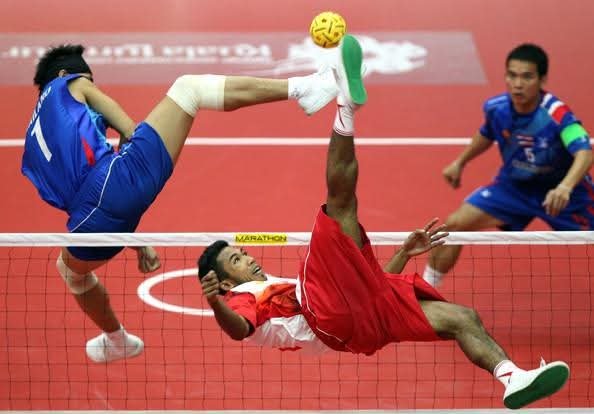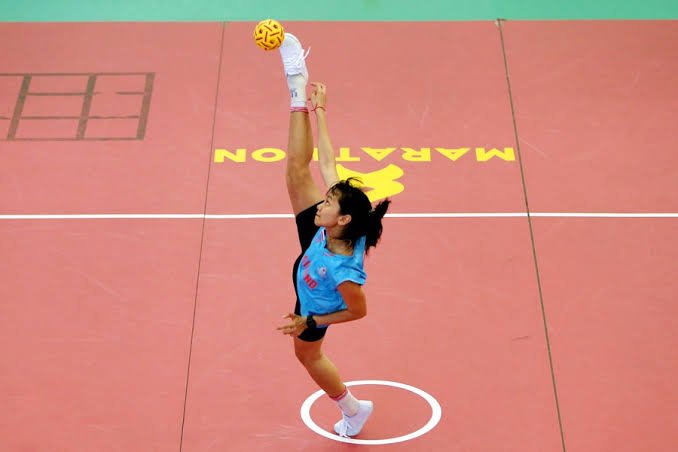Sepak Takraw
Introduction
Sepak is the Malay word for kick and takraw is the Thai word for a woven ball, therefore Sepak Takraw literally means to kick ball. The choice of this name for the sport was essentially a compromise between Malaysia and Thailand, the two powerhouse countries of the sport.
The Thai and Malay are said to have played the game as far back as the 15th century. Recorded history of the game exists in Wat Phra Kaew – the temple that serves as a resting place for the Emerald Buddha. This sacred Buddhist temple in Bangkok has murals depicting Lord Hanuman, playing takraw in a ring with a troop of monkeys.
But Sepak Takraw is not very well known in India, although it was a demonstration sport at the Delhi Asian Games in 1982.
Sepak Takraw is an exciting and dynamic sport originating in Southeast Asia, combining elements of soccer, volleyball, and martial arts. It is played with a rattan or synthetic ball and involves acrobatic movements to keep the ball in play. Here’s how to play the game:


Objective
The goal is to hit the ball over the net into the opponent’s court without letting it touch the ground on your side, scoring points when the opposing team fails to return the ball.
Players
2 teams of 3 players each (Regu format) or 2 players each (Doubles format).
Positions
Server (Tekong), Responsible for serving the ball.
Forwards/Attackers: Positioned near the net to spike and defend.
Setter: Positioned at the back to set the ball for attacks.
Equipment
A Sepak Takraw ball (traditionally made of rattan or synthetic material).
A net similar to a badminton net (height: ~1.52 meters for men, ~1.42 meters for women).
Court
Similar to a badminton court (13.4m x 6.1m).
Gameplay
- Starting the Game:
A coin toss decides which team serves first.
The server (Tekong) starts play by serving the ball from the service circle.
Rules of Play
- Serving:
The Tekong stands inside the service circle and kicks the ball over the net into the opponent’s court.
The server’s feet must not leave the ground until the ball is served.
- Ball Contact:
Players can use their feet, head, knees, chest, or shoulders to hit the ball.
Hands and arms are not allowed.
- Team Movements:
Each team can touch the ball up to 3 times before sending it over the net.
A single player cannot touch the ball consecutively twice.
- Scoring:
Points are awarded when the opponent fails to return the ball, the ball lands outside the court, or any fault occurs.
A match is typically played to 21 points in each set (best of 3 sets).
- Key Techniques:
- Serving: A precise kick from the Tekong to start the play.
- Setting: Using controlled touches to set the ball for a teammate to spike.
- Spiking: Acrobatic kicks, often involving flips, to send the ball powerfully over the net.
- Defending: Blocking or returning spikes with headers, chest, or feet.
Faults:
- Ball lands outside the boundary lines.
- Ball fails to cross the net.
- Player touches the net during play.
- Player uses hands or arms to hit the ball.
- Ball is touched more than three times by a team.
Tips for Success
- Practice agility: Flexibility and acrobatic movements are key to excelling in Sepak Takraw.
- Teamwork: Effective communication and coordination are crucial.
- Precision: Work on controlling the ball during serves, spikes, and sets.
- Defensive Skills: Learn to anticipate opponents’ moves to block or defend effectively.
Benefits of Sepak Takraw:
Enhances agility, reflexes, and coordination.
Promotes teamwork and strategy.
A thrilling and entertaining sport for players and spectators alike.
Enjoy the fast-paced, high-energy game of Sepak Takraw!
Address
Bharatiya Khel
Indian Knowledge Systems (IKS) Division
Ministry of Education (MoE),
Government of India,
Our office is located in
All India Council for Technical Education (AICTE)
Nelson Mandela Marg,
Vasant Kunj,
New Delhi-110070

